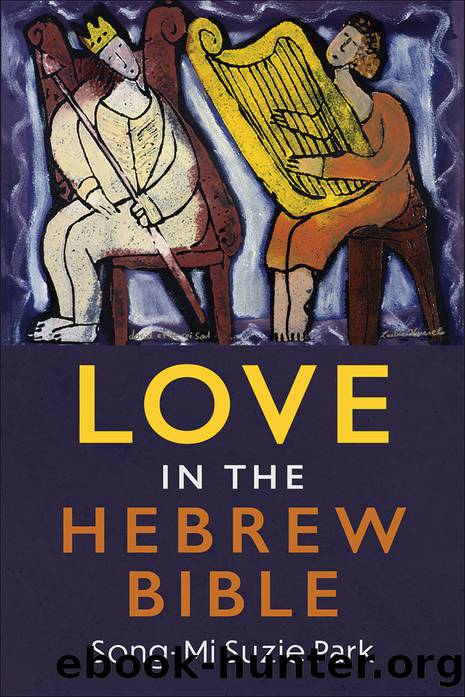Love in the Hebrew Bible by Park Song-Mi Suzie;

Author:Park, Song-Mi Suzie;
Language: eng
Format: epub
ISBN: 7255057
Publisher: Presbyterian Publishing
JONATHAN AND DAVIDâS RELATIONSHIP
The darker side of love, including betrayal, death, and dynastic collapse reaches its climax when Jonathan meets and befriends David. First Samuel 18 describes their intense introduction:
When David had finished speaking to Saul, the soul [nephesh] of Jonathan was bound to the soul [nephesh] of David, and Jonathan loved [ahav] him as his own soul [nephesh]. Saul took him that day and would not let him return to his fatherâs house. Then Jonathan made a covenant with David because he loved [ahav] him as his own soul [nephesh]. (1 Sam. 18:1â3)
Like Saul who comes to love David quickly after their meeting, so also Jonathan falls victim to Davidâs charms and is immediately and repeatedly said to love David (1 Sam. 18:1, 3). This love, moreover, is so contagious that Saul and Jonathanâs love will quickly be followed by that of Michal, Jonathanâs sister and Saulâs daughter, the court, and the people of Israel (1 Sam. 18:16, 20, 22, 28).
Considering the charged introduction, interpreters have long wondered whether the story of David and Jonathan describes a same-sex relationship and whether these characters were gay or bisexual. Undoubtedly, this has led to an immense amount of scholarship. For the sake of our analysis of love, I will quickly summarize the various positions on this question, which largely fall within an interpretative spectrum.9
On the one end are those who view the tale of David and Jonathan as clearly indicative of a same-sex relationship.10 Nancy Wilson, for example, describes David as âthe most clearly bisexual figure in the whole of the Bible,â and that Jonathan is âmore truly gayâ than David.11 Similarly, Theodore Jennings states that the introduction of Jonathan and David should be considered as âlove at first sight,â and that, not just Jonathan, but Saul, too, had a sexual relationship with David.12 These overlapping sexual relationships are, according to Jennings, the basis of the conflict among the three.13
In the middle are those commentators who are less sure about how to classify David and Jonathanâs relationship.14 Noting that being gay and its meanings reflect contemporary understandings and designations of sexual identity, which differ from those in the ancient Near East, these scholars argue that the story of Jonathan and Davidâs relationship should be, at best, viewed as evincing homoerotic allusions, images, and terminology, many of which are comparable to similar images or ideas found in other ancient Near Eastern myths, such as the famous ancient Mesopotamian tale known as the Epic of Gilgamesh.15 Many of these commentators note that the story of David and Jonathan arises from the homosocial culture of the ancient Near East and ancient Israel, and therefore reflects the social, political, theological, and gender significance of male social bonds and connections.16
On the other end of the interpretative spectrum are those who view Jonathan and Davidâs story as largely devoid of homoerotic or same-sex meanings, terminology, or imagery. Instead, using William Moranâs influential article on love in Deuteronomy, these interpreters argue that love (ahav) in the stories about Jonathan and David, like in Deuteronomy, has a largely political or covenantal, not erotic, meaning.
Download
This site does not store any files on its server. We only index and link to content provided by other sites. Please contact the content providers to delete copyright contents if any and email us, we'll remove relevant links or contents immediately.
| Exegesis & Hermeneutics | New Testament |
| Old Testament |
The Five People You Meet in Heaven by Mitch Albom(3476)
The Secret Power of Speaking God's Word by Joyce Meyer(2978)
Real Sex by Lauren F. Winner(2968)
Name Book, The: Over 10,000 Names--Their Meanings, Origins, and Spiritual Significance by Astoria Dorothy(2940)
The Holy Spirit by Billy Graham(2894)
0041152001443424520 .pdf by Unknown(2785)
ESV Study Bible by Crossway(2733)
How The Mind Works by Steven Pinker(2729)
Ancient Worlds by Michael Scott(2627)
The Meaning of the Library by unknow(2506)
Churchill by Paul Johnson(2506)
The ESV Study Bible by Crossway Bibles(2502)
The Gnostic Gospels by Pagels Elaine(2472)
MOSES THE EGYPTIAN by Jan Assmann(2374)
Jesus by Paul Johnson(2310)
City of Stairs by Robert Jackson Bennett(2309)
The Complete Dead Sea Scrolls in English (7th Edition) (Penguin Classics) by Geza Vermes(2236)
Ancient Near Eastern Thought and the Old Testament by John H. Walton(2196)
The Nativity by Geza Vermes(2180)
